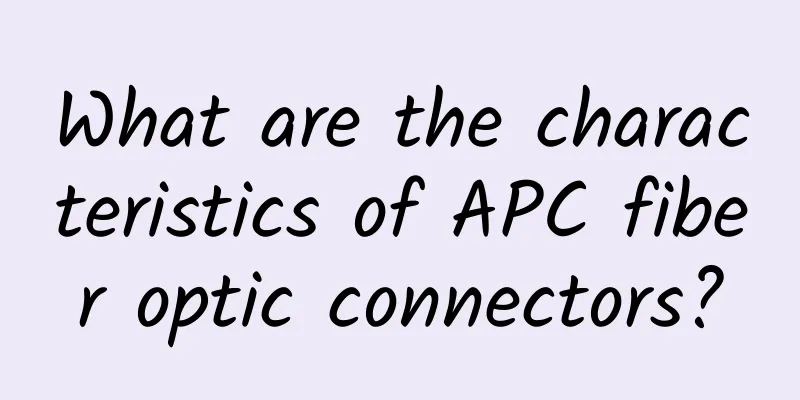What are the characteristics of APC fiber optic connectors?

|
Fiber optic connectors are mainly composed of two parts, taking the standard SC/UPC connector as an example. SC indicates the connector interface type, and UPC indicates the pin end face shape. The connector interface is divided into SC, FC, LC, ST, MPO and other types. The commonly used ones in the project are LC, FC, and SC. The connector pin end shapes are mainly PC, UPC, and APC. The difference between APC, PC and UPC
The polished front surface of the pin is spherical. This ensures that when the two ends of the two connectors meet, the physical end faces of the optical fibers are in full contact to eliminate the effect of Fresnel reflection on the system optical fiber end faces, resulting in a return loss value of 40dB or higher.
Compared with PC end faces, the geometric requirement of the industry standard UPC fiber end face is to achieve a return loss of more than 50dB. UPC is based on the polishing and surface finish optimization of the PC end face, making the end face look more round.
The fiber end face is usually polished to an 8° bevel, and the reflected light is reflected back to the cladding through the bevel, rather than directly back to the source. This minimizes back reflections, resulting in a return loss of 60dB or more. Return loss of removable connectors1. Definition of Return Loss (RL) The difference between the transmission characteristics of APC and UPC connectors is the return loss. Return loss (RL) is the decibel of the back-reflected optical power relative to the incident optical power of the optical signal at the active connector. The formula for return loss is RL=10lg(P1/P0). The larger the RL value, the smaller the optical power reflected into the optical fiber. Obviously, the larger the RL of the active connector, the better. 2. Impact of return loss on optical communication In analog optical communication systems, the intensity of optical signals is constantly changing. If the intensity of the reflected signal in the optical fiber is large, it will inevitably affect the normal signal. Therefore, the larger the RL value of the connector in the analog optical communication system, the better. In digital optical communication systems using NRZ codes, there are only two types of optical signal strength (representing "1" and "0" respectively). As long as the reflected signal in the optical fiber is not strong enough to affect the determination of signal "1", it will not affect the transmission of the optical signal. Therefore, in digital optical communication systems using NRZ codes, there are no special requirements for the RL value of active connectors. At present, in the metropolitan area network single optical module 50G, 200G, 400G optical communication system, the line code type mainly adopts PAM4 code. PAM4 code has four signal strengths, representing 11, 10, 01, and 00 respectively. If the reflected signal strength in the optical fiber is large, it may affect the judgment of the 01 signal. Therefore, the line coding of the communication system using PAM4 coding has certain requirements for the connector RL. In actual optical transmission systems, there are usually multiple active connections in a fiber transmission link, and the optical power of the reflected signal generated by each active connection is accumulated in the fiber link. Therefore, the more active connections there are in a fiber link, the higher the return loss requirement for each connector. For example, a 40km fiber link uses PAM4 encoding. When the number of active connectors in the link is 2/4/6/8, the return loss of the active connector should be no less than 27dB/32dB/35dB/37dB, respectively. 3. Impact of pin end surface contamination on return loss When the connector end face is contaminated, the return loss will increase. By testing the insertion loss and return loss of the existing UPC active connector, it is found that the connector return loss is more sensitive to end face contamination. About 20% of the active connectors in the existing network have return loss below the standard due to end face contamination, while the insertion loss is only affected when the connector end face is severely contaminated. Application scenarios of APC connectorsDue to its high loss, APC connectors are suitable for optical communication systems with high loss requirements. For example: 1. CATV and other analog optical communication systems; 2. Metro optical communication systems with line code type PAM4 of 50G, 200G, 400G and above; The previous analysis shows that PAM4 signals do not require high levels of connector loss (no less than 37dB for 8 active connections over a 40km link). However, APC connectors are recommended, and there is contamination on the connector end faces in actual optical links. For example, operators use 50G in access layer wired networks. SPN system (8 active connections across the link). Some systems experienced increased error counts, local fault reporting, and intermittent disconnects on 50G ports due to the use of PAM4 line code and UPC connectors. Troubleshooting after replacing the APC. 3. WDM system using Raman fiber amplifier. The fiber end face of the APC connector is an 8° bevel, and its cross-sectional area is larger than that of the UPC connector. The larger fiber cross-sectional area and greater return loss make the APC connector more suitable for carrying higher optical power. Currently, Raman fiber amplifiers are commonly used in single-carrier ultra-100G wavelength division systems; the reverse output optical power of Raman fiber amplifiers can reach 30dBm. If a UPC connector is used, it is easy to burn the fiber end of the connector. Therefore, the manual of the equipment using the Raman fiber amplifier usually explicitly requires the use of an APC connector. The dimensions of APC and UPC connectors with the same interface are basically the same. Although they are physically connectable, the insertion loss after connection is large (over 4.0dB) due to the difference in the pin end faces. Therefore, APC and UPC connectors cannot be mixed. Currently, operators' optical wiring equipment generally uses UPC active connections. With the increasing use of line code PAM4 communication systems and Raman fiber amplifier WDM systems, the shortcomings of UPC active connectors are increasingly exposed, and optical fiber active connectors should transition from UPC to APC as soon as possible. |
<<: How to manage data center cabling?
>>: The key role of network connectivity in the development of smart cities
Recommend
HostYun: Hong Kong high bandwidth VPS 10% off monthly payment starting from 18 yuan, 50-100M bandwidth
HostYun has launched a new product, this time it ...
The total investment of China Mobile, China Unicom and China Telecom does not exceed 34.2 billion! 5G cannot be swallowed in one go, so it needs to be eaten slowly.
As 5G enters its first year of commercial use, th...
New "skills" and "higher salaries" - Ruijie launches new service certification products
Recently, Ruijie Networks released two new servic...
BandwagonHost has launched a new SoftBank line in Osaka, Japan, with an annual fee starting from US$65
bandwagonhost is a subsidiary of the old IT7 comp...
Inventory of common Ul Ol lists and common list marker icons in HTML
[[402167]] 1. Concept The CSS list properties are...
EBS Lens, a powerful tool for block storage monitoring and service stress testing and tuning, is released
EBS Monitoring Status Block storage is a block de...
Can you understand Wdm in one minute?
Hello everyone, I am Xiaozaojun. [[329660]] When ...
Why is it so difficult for operators? How can it not be difficult when they are faced with difficulties along the way?
[[353944]] This article is reprinted from the WeC...
CloudCone: $17.99/year KVM-1GB/50GB/1TB/Los Angeles MC Data Center
CloudCone sent an email at the beginning of the m...
Gouyun 618 promotion: 30% off on Elastic Cloud, 20% off on Classic Cloud, Hong Kong dedicated server from 300 yuan/month, recharge 618 yuan and get 68 yuan
DogYun is a Chinese hosting company founded in 20...
VMISS adds 30% off on Tokyo data center in Japan, and monthly VPS in Los Angeles CN2 GIA/AS9929/Hong Kong/Korea/Japan starts from 3.5 Canadian dollars
VMISS recently added a second node in Japan, Toky...
Making WAN ubiquitous: SD-WAN still has huge room for development
[[177476]] The impact of globalization has become...
Super detailed explanation of Socket communication principles and examples
We are well aware of the value of information exc...
What happens behind the scenes when the Ping command is issued?
01 Overview [[274853]] As for the ping command, I...
DediPath New Year's Day promotion: 1Gbps unlimited traffic VPS from $9 per year, dedicated server from $39/month, multiple data centers in Los Angeles and other places
DediPath has launched another promotion during th...









